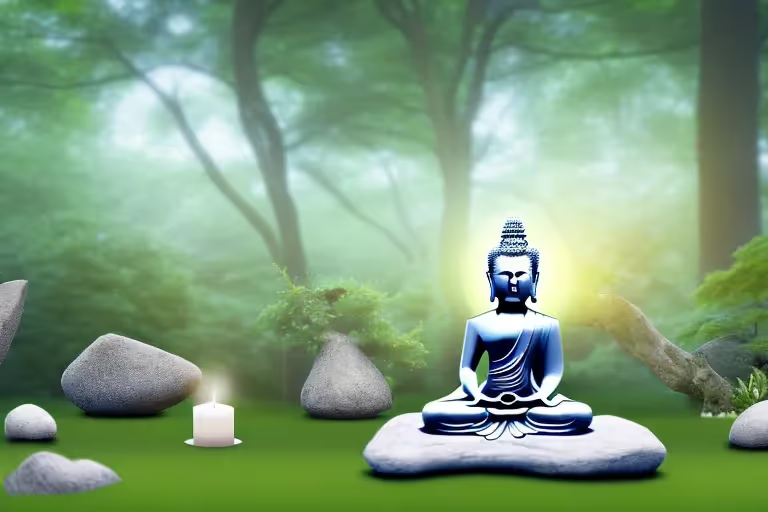Ah, savasana! Many people first experience yoga nidra as the blissful final few minutes of a yoga class when you rest in corpse pose and relax the body. But yoga nidra is a powerful practice that goes far beyond being the dessert at the end of a yoga class!
Yoga Nidra is a powerful technique that can be practiced on its own to induce complete physical, mental, and emotional relaxation that can reduce stress and create powerful shifts in your subconscious mind.
This post shares all you need to know to start practicing yoga nidra.
What Is Yoga Nidra?
The term “nidra” means sleep in Sanskrit and “yoga nidra” translates to “yogic sleep.”
Yoga nidra is an ancient practice that induces a trance-like state by deeply relaxing the body, allowing you to access higher levels of consciousness for healing and increased receptivity.
Yoga, in this sense, describes the spiritual philosophy of ascending to a higher self-awareness and divine consciousness within, not just the physical practice of down dogs and warriors on the mat.
Much like how breathwork and meditation are used in yoga to cultivate a deeper level of awareness, yoga nidra is reached by turning inwards, away from outer experiences, relaxing the body, and withdrawing from the senses. The goal is a state of transcendental deep relaxation.
The “sleep” in “yogic sleep” can be misleading. In yoga nidra, the goal is not to fall asleep but to remain awake and aware, yet in complete stillness of the thoughts and senses for ultimate receptivity.
Yoga nidra is the threshold state between sleep and wakefulness, where contact with the subconscious and unconscious dimensions occurs simultaneously.
Benefits of Yoga Nidra
Deep Rest and Relaxation
Yoga nidra takes place lying down, encouraging you to relax every muscle in your body. By seeking complete relaxation, the mind softens and you are guided into a blissful deep rest. Most yoga masters agree that doing 1 minute of yoga nidra offers the equivalent amount of rest for the body as 4 minutes of sleep!
Reduced Stress
By relaxing the body, yoga nidra helps activate your parasympathetic nervous system, lowering cortisol (stress hormone) levels, making it extremely effective in relieving stress. Practicing yoga nidra instantly makes you feel better, and it’s helpful with overall stress management, improving long-term stress and anxiety.
Improved Sleep Quality
The goal of yoga nidra is not to fall asleep, but to linger in a relaxed semi-conscious state. However, practicing yoga nidra can help with overall sleep quality. According to the National Sleep Foundation, Yoga Nidra’s calming effect on the nervous system can reduce overall stress, eliminating the underlying cause of insomnia and poor sleep.
Emotional Healing and Balance
With advanced yoga nidra practices, you can send your subconscious mind and body messages to reset belief patterns and release tension and trauma. This is done through setting an intention, using visualization, somatic body awareness, affirmations and other techniques.
Spiritual Growth
Yoga nidra offers a way to explore your deeper levels of consciousness. Much like meditation, it’s an exploration of the inner self.
How To Get Started Practicing Yoga Nidra
Begin With A Guided Yoga Nidra Session
It’s best to begin with guidance to fully relax and experience the process. You can work with a yoga nidra facilitator in person or listen to recorded tracks. Simply lie down comfortably and follow the instructions.
With experience, you can learn to guide yourself into yoga nidra. However, even the most advanced yogis appreciate the gentle guidance of a facilitator.
What To Expect In A Guided Yoga Nidra Session
In a yoga nidra session, you can expect to be guided through a series of relaxation techniques while lying comfortably. You may explore some or a combination of these key techniques to help you withdraw from your senses, including setting an intention, a body scan to release tension, breath awareness (pranayama) and visualization exercises.
As you follow the instructions, you'll enter a deep state of relaxation, allowing your mind and body to rest and rejuvenate. At the end of the session, you will be gently re-awakened, guided to make small movements, and reconnect with your breath and body. After the session, you will feel deeply rested, calm, and renewed.
Key Relaxation Techniques In Yoga Nidra
A Yoga Nidra session typically involves all or some combination of these meditation and relaxation techniques:
Intention Setting. Entering into a practice of yoga nidra involves focusing on an intention (sankalpa in yoga) or personal desire, which can be phrased as a short affirmation to guide your practice. Often during intention setting, you will tell yourself, “I am practicing yoga nidra, I will not fall asleep.”
Because yoga nidra is so relaxing, it’s easy to fall asleep during a session. Remember, the goal of yoga nidra is to remain between fully awake and falling asleep. It may be hard to linger in this transcendental state for long, but if you just reach a minute or two, you will reap the many benefits of yoga nidra. So this intention setting becomes an important reminder to not fall asleep during the session can help you remain in a more trance-like, semi-conscious state.
Body Scan And Relaxation. You'll be guided to move inward with somatic awareness to sense any tension within. Often, you’ll be guided systematically through a deep relation of each part of your body. This allows your body to release tension, setting the stage for inward focus and deep rest.
Breath Awareness (Pranayama). Calming breath exercises help your body relax, eventually allowing your mind to surrender to stillness.
Visualization. Mental imagery through your third-eye can deepen your meditative state and help you work through energy healing and experience a deep release.
Beginner Yoga Nidra Tips
Do Not Practice Yoga Nidra In Bed. It’s best to keep the practice of yoga nidra and falling asleep as separate activities. While yoga nidra can help you relax to fall asleep, practice it as an evening wind-down activity before getting into bed. If you practice yoga nidra to intentionally fall asleep, your mind will confuse the two practices and you will have a difficult time lingering in a semi-conscious state when you intend to.
Find A Comfortable Position. Yoga nidra is often practiced in corpse pose, lying flat on your back with your arms resting along the sides of your body. It's important to ensure you're comfortable in this pose to fully relax. Use pillows or bolsters to find a way to remain comfortable for a length of time. Cover yourself with a blanket, if needed, as often our body temperature cools down when we enter deep relaxation. Consider using an eye pillow or eye mask to block out light. If lying on your back is uncomfortable, try lying on your side or reclining in a chair. Explore whatever adjustments are necessary to stay comfortable and still during your practice.
Try Yoga Nidra After Physical Exercise. Many yoga classes end in corpse pose (savasana) and deep relaxation because the body is more open to relaxing and receiving after physical practice. Many people find that practicing Yoga Nidra after a workout or stretching helps them ease more quickly into relaxation and letting go of their thoughts. Yoga nidra also offers the body restorative benefits, helping to release any remaining tension and improve workout recovery.
Guided Session Resources. If you are looking for some guided yoga nidra tracks, here are a few of my own on Aura that are great for beginners:
- Deep Rest for Stress Release Yoga Nidra: A 14-minute practice to reset the nervous system.
- Let Go of Stress and Worry Yoga Nidra: A soothing, 22-minute deep relaxation to release stress and worry.
You can also catch me for free yoga nidra sessions on Aura Live or book a personal 1:1 yoga nidra coaching session.
The Takeaway: Yoga Nidra is a deeply relaxing practice that guides you into conscious rest, helping reduce stress and improving your overall well-being. The practice can be an extremely calming and blissful healing experience. It’s best to start practicing yoga nidra with the guidance of a facilitator. Remember to resist the temptation to fall asleep, find a comfortable position, set an intention, and follow guided techniques to fully experience relaxation and healing benefits.



.webp)







.avif)

%20(1).avif)


.avif)
.avif)
.webp)


.avif)


















































































































.avif)

















.svg)









